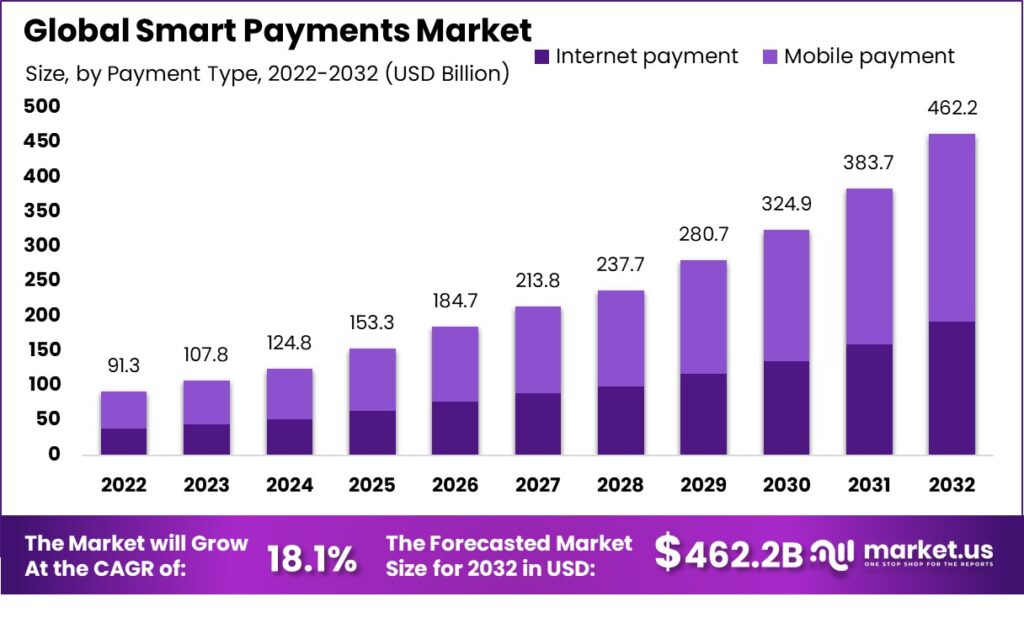The smart payments market is a rapidly growing market that is being driven by the increasing adoption of mobile devices, the growing popularity of contactless payments, and the development of new technologies such as blockchain.
The Global Smart Payments Market Sales Estimated to Surpass USD 462.2 Billion by 2032 from USD 91.3 Billion in 2022, Projected to Achieve 18.1% CAGR during the forecast period 2023 to 2032.

Key Takeaways
- The Asia-Pacific region is expected to be the fastest-growing market for smart payments.
- The key drivers of the smart payments market include the increasing adoption of mobile devices, the growing popularity of contactless payments, and the development of new technologies such as blockchain.
- The major challenges facing the smart payments market include security concerns, lack of adoption, and regulatory hurdles.
- The key opportunities in the smart payments market include the growth of e-commerce, the increasing demand for contactless payments, and the development of new technologies such as biometric payments.
Don’t miss out on business opportunities | Get sample pages at: https://market.us/report/smart-payments-market/request-sample/
Market Trends
The smart payments market is being influenced by a number of trends, including:
- The increasing adoption of mobile devices: Mobile devices are becoming increasingly popular, and this is driving the adoption of mobile payments. Mobile payments are convenient and secure, and they offer a number of advantages over traditional payment methods.
- The growing popularity of contactless payments: Contactless payments are becoming increasingly popular, as they are quick and easy to use. Contactless payments can be made using a variety of devices, such as smartphones, wearables, and credit cards.
- The development of new technologies: The development of new technologies, such as blockchain and biometrics, is also having a major impact on the smart payments market. Blockchain is a secure and decentralized ledger that can be used to record payments. Biometrics is the use of physical characteristics, such as fingerprints and facial scans, to authenticate users.
Drivers
The following are the key drivers of the smart payments market:
- Increasing adoption of mobile devices: Mobile devices are becoming increasingly popular, and this is driving the adoption of mobile payments. Mobile payments are convenient and secure, and they offer a number of advantages over traditional payment methods.
- Growing popularity of contactless payments: Contactless payments are becoming increasingly popular, as they are quick and easy to use. Contactless payments can be made using a variety of devices, such as smartphones, wearables, and credit cards.
- Development of new technologies: The development of new technologies, such as blockchain and biometrics, is also having a major impact on the smart payments market. Blockchain is a secure and decentralized ledger that can be used to record payments. Biometrics is the use of physical characteristics, such as fingerprints and facial scans, to authenticate users.
- Growth of e-commerce: E-commerce is growing rapidly, and this is driving the demand for smart payments. E-commerce transactions are often made online, and smart payments offer a convenient and secure way to make these payments.
Restraints
The following are the key restraints of the smart payments market:
- Security concerns: Some people are concerned about the security of smart payments, especially when using new technologies such as cryptocurrencies.
- Lack of awareness: Some people are not aware of the benefits of smart payments, and this can be a barrier to their adoption.
- Regulatory hurdles: Governments are still working to develop regulations for smart payments, which can slow down their adoption.
Challenges
The following are the key challenges facing the smart payments market:
- Security: Smart payments need to be secure in order to gain widespread adoption. This is a challenge, as new security threats are constantly emerging.
- Interoperability: Smart payments need to be interoperable in order to be widely adopted. This means that they need to be able to work with different devices and systems.
- Acceptance: Merchants need to be willing to accept smart payments in order for them to be successful. This is a challenge, as some merchants are hesitant to adopt new technologies.
Find additional highlights on the growth strategies adopted by vendors and their product offerings, Buy Sample Report.
Opportunities
The following are the key opportunities in the smart payments market:
- Growth of e-commerce: E-commerce is growing rapidly, and this is driving the demand for smart payments. E-commerce transactions are often made online, and smart payments offer a convenient and secure way to make these payments.
- Increasing demand for contactless payments: Contactless payments are becoming increasingly popular, as they are quick and easy to use. Contactless payments can be made using a variety of devices, such as smartphones, wearables, and credit cards.
- Development of new technologies: The development of new technologies, such as blockchain and biometrics, is also having a major impact on the smart payments market. These technologies offer new possibilities for making payments more secure, efficient, and convenient.
The following are some of the major players in the industry
- American Express Company
- Apple Inc.
- Google LLC
- MasterCard
- One Communication Limited
- PayPal Holdings Inc.
- Samsung
- Amazon.com, Inc.
- Square. Inc.
- Other Key Players
Market Segments
By Payment Type
- Internet Payments
- Mobile Payments
By End-use Industry
- Retail
- Transportation
- Hospital
- Media and Entertainment
- Other End-use Industry